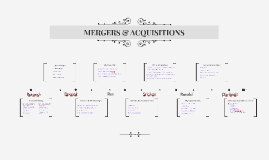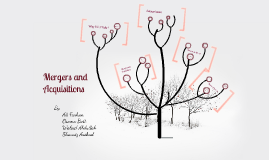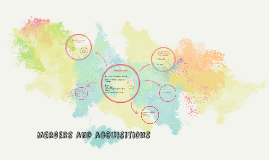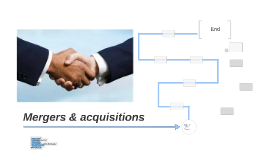Mergers And Acquisitions
Transcript: Phases of M & A Why M & A Fails ? Poor strategic fit - The two companies have strategies and objectives that are too different and they conflict with one another. Cultural and Social Differences - It has been said that most problems can be traced to "people problems." If the two companies have wide differences in cultures, then synergy values can be very elusive. cntd...... Incomplete and Inadequate Due Diligence - Due diligence is the "watchdog" within the M & A Process. If you fail to let the watchdog do his job, you are in for some serious problems within the M & A Process. Poorly Managed Integration - The integration of two companies requires a very high level of quality management. Integration is often poorly managed with little planning and design. As a result, implementation fails . Paying too Much - In today's merger frenzy world, it is not unusual for the acquiring company to pay a premium for the Target Company. Premiums are paid based on expectations of synergies. However, if synergies are not realized, then the premium paid to acquire the target is never recouped. Overly Optimistic - If the acquiring company is too optimistic in its projections about the target Company, then bad decisions will be made within the M & A Process. An overly optimistic forecast or conclusion about a critical issue can lead to a failed merger. THANKYOU Catagorization Conglomerate Every merger has its own unique reasons why the combining of two companies is a good business decision. The underlying Principle behind mergers and acquisitions ( M & A ) is simple: 2 + 2 = 5 Two firms are merged across similar products or services. Horizontal mergers are often used as a way for a company to increase its market share by merging with a competing company. For example, the merger between Exxon and Mobil will allow both companies a larger share of the oil and gas market. Bargain Purchase - It may be cheaper to acquire another company then to invest internally. Diversification - It may be necessary to smooth-out earnings and achieve more consistent long-term growth and profitability. Short Term Growth - Management may be under pressure to turnaround sluggish growth and profitability. Undervalued Target - The Target Company may be undervalued and thus, it represents a good investment. M&A defined Well for starters, mergers and acquisitions are now a normal way of life within the business world. In today's global, competitive environment, mergers are sometimes the only means for long-term survival. When we use the term "merger", we are referring to the merging of two companies where one new company will continue to exist. The term "acquisition" refers to the acquisition of assets by one company from another company. Positioning - Taking advantage of future opportunities that can be exploited when the two companies are combined. Gap Filling - One company may have a major weakness (such as poor distribution)whereas the other company has some significant strength. Organizational Competencies - Acquiring human resources and intellectual capital can help improve innovative thinking and development within the company. Broader Market Access - Acquiring a foreign company can give a company quick access to emerging global markets. Phase 5-Post Merger Integration If all goes well, the two companies will announce a agreement to merge the two companies. The deal is finalized in a formal merger and acquisition agreement. Every company is different - differences in culture, differences in information systems, differences in strategies, etc. As a result, the Post Merger Integration Phase is the most difficult phase within the M & A Process. Mergers and Acquisitions Two firms in completely different industries merge, such as a gas pipeline company merging with a high technology company. Conglomerates are usually used as a way to smooth out wide fluctuations in earnings and provide more consistency in long-term growth. Typically, companies in mature industries with poor prospects for growth will seek to diversify their businesses through mergers and acquisitions. Phase 1 - Pre Acquisition Review Phase 2 - Search & Screen Targets Phase 3 - Investigate & Value the Target Phase 4 - Acquire through Negotiation Phase 5 - Post Merger Integration Reasons for M & A Mergers and acquisitions represent the ultimate in change for a business. No other event is more difficult, challenging, or chaotic as a merger and acquisition. Hence it is imperative that everyone involved in the process has a clear understanding of how the process works. Two firms are merged along the value-chain, such as a manufacturer merging with a supplier. Vertical mergers are often used as a way to gain a competitive advantage within the marketplace. For example, Merck, a large manufacturer of pharmaceuticals, merged with Medco, a large distributor of pharmaceuticals, in order to gain an advantage in distributing its Products. By Ali Farhan Osama Butt Waleed Abdullah Shavaiz Arshad

















